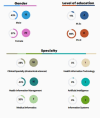A practical framework for developing a virtual reality-based anatomy education application: key content and technical requirements
- PMID: 40216863
- PMCID: PMC11992126
- DOI: 10.1038/s41598-025-96074-8
A practical framework for developing a virtual reality-based anatomy education application: key content and technical requirements
Abstract
Anatomy is a requirement for medical education, which is necessary for the healthcare system to train professionals, improve their abilities, competencies, and practical experience, and fulfill society. The aim of this study is to provide a practical framework for developing virtual reality-based (VR) anatomy education applications by ascertain the technological and content specifications. This descriptive-analytical study was conducted in 2023-2024 and consisted of three steps. In the first step, related studies were reviewed to extract technical requirements, including software features and facilities. In the second step, VR software stores, such as Steam, Meta, and SideQuest were also examined to consider the most complete technical facilities, and similar software was considered. To this end, information related to the software, including the name of the software, headset and equipment, number of users (single user/multiple users), development tools, 3D material, anatomical position, and the key features are collected in Excel (version 2019). In the third step, seven curriculums of the anatomy course of the undergraduate degree in paramedical fields (including medical laboratory sciences, surgical technology, radiation therapy, radiology, health information technology, emergency care, and anesthesiology) were collected to identify the content requirements. Finally, a list of content and technical features was compiled. By examining software and literature, the research team for this study was able to determine the technological and content requirements. Following the elimination of duplicates, we were left with 80 technical and content requirements, divided into eight and two axes, respectively. The survey was distributed to 124 experts to assess technical and content requirements, and responses were received from a select group of participants, 35 experts. Consequently, we were able to identify 23 content needs that were divided into two axes and 57 technological requirements that were divided into eight categories. Statistical analysis was performed using SPSS (version 27). Developers may create educational anatomy software based on VR that not only engages learners but also significantly enhances their grasp of complex anatomical structures by carefully identifying and resolving technical and content needs.
Keywords: Anatomy; Education; Teaching; Virtual reality.
© 2025. The Author(s).
Conflict of interest statement
Declarations. Ethics approval and consent to participate: All methods were carried out in accordance with relevant guidelines and regulations. The methodology for this study was approved by the Ethics committee of Tehran University of Medical Sciences with the ethics code IR.TUMS.SPH.REC.1402.060 and with 1402–1-102–64856 proposal code. All participants (or their legal guardians) were provided verbal informed consent for all stages of study and the Ethics committee of Tehran University of Medical Sciences approved this procedure. Competing interests: The authors declare no competing interests.
Figures
Similar articles
-
Reviewing the current state of virtual reality integration in medical education - a scoping review.BMC Med Educ. 2024 Jul 23;24(1):788. doi: 10.1186/s12909-024-05777-5. BMC Med Educ. 2024. PMID: 39044186 Free PMC article.
-
Developing 3D models using photogrammetry for virtual reality training in anatomy.Anat Sci Educ. 2023 Nov-Dec;16(6):1033-1040. doi: 10.1002/ase.2301. Epub 2023 May 29. Anat Sci Educ. 2023. PMID: 37248365
-
Systematic analysis of anatomy virtual reality (VR) apps for advanced education and further applications.Sci Rep. 2024 Dec 30;14(1):31835. doi: 10.1038/s41598-024-82945-z. Sci Rep. 2024. PMID: 39738416 Free PMC article.
-
The effectiveness of immersive virtual reality applications (human anatomy) on self-directed learning competencies among undergraduate nursing students: A cross-sectional study.Anat Sci Educ. 2024 Dec;17(9):1764-1775. doi: 10.1002/ase.2534. Epub 2024 Nov 7. Anat Sci Educ. 2024. PMID: 39508164
-
The effectiveness of virtual reality-based technology on anatomy teaching: a meta-analysis of randomized controlled studies.BMC Med Educ. 2020 Apr 25;20(1):127. doi: 10.1186/s12909-020-1994-z. BMC Med Educ. 2020. PMID: 32334594 Free PMC article. Review.
Cited by
-
Digital health economics education: perspectives, potential and barriers at German medical universities.Front Med (Lausanne). 2025 Aug 1;12:1624347. doi: 10.3389/fmed.2025.1624347. eCollection 2025. Front Med (Lausanne). 2025. PMID: 40823547 Free PMC article.
References
-
- Rosmansyah, Y., Putri, A., Koesoema, A. P., Latief, A. & Amalia, Y. S. in AIP Conference Proceedings. (AIP Publishing).
-
- Adnan, S. & Xiao, J. A scoping review on the trends of digital anatomy education. Clin. Anat.36, 471–491 (2023). - PubMed
MeSH terms
LinkOut - more resources
Full Text Sources
Medical



